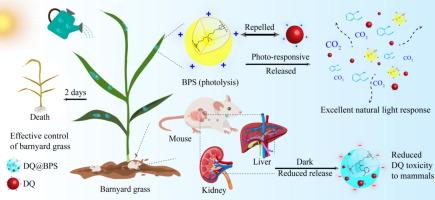电荷可逆-自然光响应纳米粒子能够靶向除草剂递送和降低哺乳动物毒性
IF 13
1区 综合性期刊
Q1 MULTIDISCIPLINARY SCIENCES
引用次数: 0
摘要
由农用化学品暴露引起的哺乳动物健康风险正日益成为全球关注的问题。长期暴露于diquat (DQ)会导致多器官功能障碍,并增加哺乳动物死亡率。尽管现有的缓解策略,包括氧化应激减少和肠道微生物群调节,但DQ中毒的有效缓解策略仍然难以捉摸。目的根据哺乳动物黑暗的胃肠环境,制备一种能有效防治杂草和降低对哺乳动物毒性的天然光响应型DQ制剂。方法通过负载DQ到具有电荷反转性质的桥式聚硅氧烷(BPS)上,制备天然光响应配方DQ@BPS。采用一系列表征方法对BPS和DQ@BPS的理化性质进行了研究。在自然光下,通过分子动力学模拟测试了DQ@BPS的光控释放特性。比较了DQ@BPS对稗草的防治效果,并与DQ和一种市售配方进行了比较。用小鼠模型研究其毒性。此外,还检测了BPS在大白菜中的安全性和DQ@BPS在蚯蚓中的安全性。结果证实DQ@BPS能够通过自然光释放DQ。BPS在自然光条件下反向为正电荷,DQ通过静电斥力释放,总释放量是黑暗条件下的7.27倍。与DQ相比,DQ@BPS改善了小鼠的肝脏和肾脏损伤,同时减少了10倍以上的体内残留物,并对谷仓草有有效的控制。对蚯蚓安全,LC50 >; 1000 μg/cm2,载体本身对大白菜安全。结论电荷可逆的天然光响应纳米颗粒能够降低哺乳动物对除草剂的毒性。本研究为农用化学品输送系统提供了一种新的光响应机制,为降低农用化学品对哺乳动物的毒性提供了一条有希望的途径。本文章由计算机程序翻译,如有差异,请以英文原文为准。

Charge reversible-natural light responsive nanoparticles enable targeted herbicide delivery and reduction of mammalian toxicity
Introduction
Mammalian health risks due to agrochemical exposure are becoming a global concern, increasingly. Long-term exposure to diquat (DQ) leads to multiple organ dysfunctions and increase mammal mortality. Despite existing mitigation strategies, including oxidative stress reduction and gut microbiota modulation, effective mitigation strategies for DQ poisoning remain elusive.Objectives
Based on the dark gastrointestinal environment of mammals, a natural light-responsive DQ formulation was prepared, that effectively controls weeds and reduces toxicity to mammals.Methods
By loading DQ onto bridged polysilsesquioxane (BPS) with charge reversal properties, a natural photo-responsive formulation of DQ@BPS was prepared. The physicochemical properties of BPS and DQ@BPS were studied with a series of characterization methods. Under natural light, the photo-controlled release properties of DQ@BPS were measured by molecular dynamics simulation. The control effect of DQ@BPS to barnyard grass was compared with that of DQ and a commercial formulation. A mouse model was used to study its toxicity. In addition, the safety of BPS in Chinese cabbage and DQ@BPS in earthworms were detected.Results
We verified that DQ@BPS enable release DQ through natural light. BPS was reversed to a positive charge under natural light, and DQ was released via electrostatic repulsion, with a total release amount 7.27 times that under darkness. Compared with DQ, DQ@BPS ameliorated the liver and kidney damage while reducing body residues by over 10 times in mice, and showed effective control of barnyard grass. Furthermore, it was safe for earthworms, LC50 > 1000 μg/cm2, and the carrier itself was safe for Chinese cabbage.Conclusion
Charge-reversible-natural light-responsive nanoparticles enable to deliver herbicide with reduced mammalian toxicity. This study provides a new photo-response mechanism in agrochemical delivery systems, offering a promising approach for reducing the toxicity of agrochemicals to mammals.求助全文
通过发布文献求助,成功后即可免费获取论文全文。
去求助
来源期刊

Journal of Advanced Research
Multidisciplinary-Multidisciplinary
CiteScore
21.60
自引率
0.90%
发文量
280
审稿时长
12 weeks
期刊介绍:
Journal of Advanced Research (J. Adv. Res.) is an applied/natural sciences, peer-reviewed journal that focuses on interdisciplinary research. The journal aims to contribute to applied research and knowledge worldwide through the publication of original and high-quality research articles in the fields of Medicine, Pharmaceutical Sciences, Dentistry, Physical Therapy, Veterinary Medicine, and Basic and Biological Sciences.
The following abstracting and indexing services cover the Journal of Advanced Research: PubMed/Medline, Essential Science Indicators, Web of Science, Scopus, PubMed Central, PubMed, Science Citation Index Expanded, Directory of Open Access Journals (DOAJ), and INSPEC.
 求助内容:
求助内容: 应助结果提醒方式:
应助结果提醒方式:


